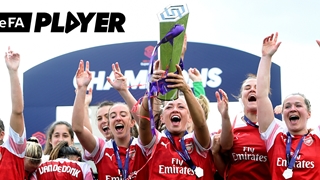
Katie Brazier, The FA’s head of women’s leagues and competitions, spoke to TheFA.com about today’s awarding of Tier 1 and Tier 2 club licences.
Katie, tell us a bit about the process...
The decision to restructure the women’s football pyramid was announced back in September 2017 in line with The FA’s The Gameplan for Growth strategy, which aims to transform the women’s game both on and off the pitch. Today’s announcements are a result of nearly two years of planning and work.
As a result of the restructure, clubs competing in Tier 1 and Tier 2 of the women’s pyramid of football will now be subject to increased requirements both on and off the field. As part of these new criteria, Tier 1 clubs will have to provide a full-time professional environment for their players.
Existing FA Women’s Super League 1 and 2 clubs (FA WSL) were given the opportunity to apply for a licence to participate in the new competitions ahead of an open application phase for clubs outside of The FA WSL. Following a detailed assessment by a panel of experts, The FA Women’s Football Board decided to offer all FA WSL clubs who applied for a licence as part of the initial process, a licence in the Tier which they applied for. For some clubs this offer was conditional on them ensuring that certain requirements were met before the award was confirmed. This process left two licences available in Tier 1 and five licences in Tier 2.
The open application phase (which invited bids from clubs who had a women’s or girls’ team playing affiliated football) began in November 2017 with a workshop for interested clubs. The formal process then started in January 2018 and applications were due in by 9 March. Any existing FA WSL clubs which hadn’t applied as part of the initial application phase were welcome to submit an application as part of the open application process. 15 clubs applied across Tier 1 and Tier 2 during this phase.
The applications were assessed by a panel of experts across a range of fields including finance, marketing and commercial, facilities, player development, coaching and performance. Each club was then invited to an individual interview.
Finally, The FA Women’s Football Board met on Wednesday 23 May to assess all the application information and make its decision.
Outside of the processes described above, one spot was available for the winner of Sunday’s The FA WPL Championship Play-Off, subject to the Champion Club meeting the licence criteria. This was secured by Charlton Athletic Women.
In addition to the licences awarded in December 2017 and the winner of the Play-Off final the following licences have been awarded following the open application phase:
Tier 1: The FA Women’s Super League– West Ham United Ladies
Tier 2: The FA Women’s Championship – Leicester City Women, Lewes FC Women, Manchester United Women & Sheffield United Ladies.
All clubs awarded a licence to participate in the new competitions for 2018-19 onwards are required to sign a licence with The FA and any awards made by the Women’s Football Board are conditional on all clubs signing and returning a licence in the form requested by The FA.
How hard were the decisions you had to make?
We have been through an extremely thorough and detailed process. We know that there are a number of knock-on effects resulting from the outcome of the application process and I can assure you that all decisions have been made with the respect and due diligence that they deserve. For those clubs which were unsuccessful, we understand there will be disappointment and we’ll be working with each of them to provide support and guidance. With promotion and relegation now established across all levels of the pyramid there are opportunities for clubs to progress in the future and I’m sure many will continue the great work they are doing to achieve this.
What’s your message to those clubs who were successful?
Huge congratulations to all our successful clubs. The quality of applications was excellent and within the process they have all shown why they deserve a place within the highest levels of the women’s game. It is an extremely exciting time and we’re delighted to welcome the new clubs their players, staff and fans to The FA WSL and FA Women’s Championship.
Tier 1 will have an uneven number of teams (11), why has that happened and what’s the impact of that decision?
We have 11 teams because just one club applied for Tier 1 within the open application phase. West Ham United Ladies’ application was extremely impressive and warranted a place in Tier 1, and congratulations to them. We will even the numbers for the following season via promotion and relegation.
What will happen to the three FA WSL 1 and 2 clubs which weren’t successful?
We understand that this will be disappointing for the three clubs who were occupying spots in The FA WSL. We will speak to the clubs to ensure they are placed at the right level within the women’s football pyramid for the 2018-19 season.
When will we know more about the make-up of the National League Northern and Southern Premier Division (Tier 3) and The National League Division 1, North, Midlands, South East and South West (Tier 4)?
We would anticipate being able to announce in June. The women’s football pyramid operates a promotion pool between County and Regional Leagues. The decisions around these promotion applications will be made at the end of May and this in turn will inform the promotion and relegation movement between the Regional Leagues and Tier 4 and 3 of The FA Women’s National League, whilst ensuring the vacancies created by the Tier 1 and 2 licencing process are filled.
When does the season start?
The season begins on the weekend of the 18/19 August with the opening fixtures of group rounds of The FA Continental Tyres Cup. The FA Women’s Super League and The FA Women’s Championship league fixture programme will then commence on the weekend of the 8/9 September. The FA Women’s National League commences on 19 August.
In June, you’ll see the launch of the new logos and visual identities to accompany all three leagues. So keep an eye on FA channels for that.
It will be a landmark season for the women’s game and the world of women’s football will be watching, I cannot wait to get started.
What are your hopes for the future of women’s football?
The growth and development of women’s football is one of The FA’s major priorities. I’m confident this decision will significantly influence the three key objectives of 'The Gameplan for Growth' strategy, helping us to double participation, double the fanbase and also improving chances of consistent success for our international teams.
If you consider the potential impact, I think we will look back upon this decision as one of the most important decisions made in the history of the women’s game.









